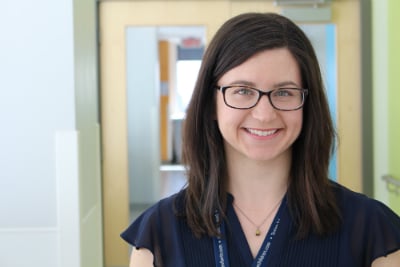
A rare respiratory disease may be more prevalent in Quebec
27 November 2025
Rise in respiratory infections and measles outbreak: important infection prevention measures at the Montreal Children’s Hospital.
Read moreWelcome to the Montreal Children's Hospital

4 May 2016
What does a speech language pathologist do? It’s a question that Caroline Richer often hears. “Compared to a decade ago, there are definitely more people who know about our profession,” says Caroline. “What many people don’t realize, though, is how varied our work can be, especially in a pediatric hospital like the Children’s.”
As one of seven speech language pathologists (SLP) at the Children’s, Caroline is a good example of how varied that work can be. She not only sees inpatients with brain tumors or traumatic brain injuries but she works with outpatients in the developmental progress, autism spectrum disorders, and neonatal follow-up clinics. SLPs often specialize in areas of speech or language, and Caroline’s work frequently focuses on language skills and abilities.
Evaluating language skills
“Much of my work involves evaluating a child’s language skills—that is, comprehension and expression. Expressive language includes vocabulary, grammar, how well they use language, as well as sound production skills,” she says. “The treatments we recommend depend on the assessment results.” In clinic, her patients are typically under five years old, but inpatients can be up to 18 years old. “I really like the variety that comes with working in a pediatric teaching hospital in such a multicultural context, like Montreal. We routinely complete bilingual or multilingual assessments and frequently work with interpreters.”
Caroline also highly values being a clinical educator. She was recently nominated by her students for an Award for Excellence in Clinical Teaching. “I enjoy the fast-paced environment at the Children’s and not necessarily knowing what’s coming next. There are often new challenges, but working on multidisciplinary teams is a tremendous asset and it brings a lot to the patients.”
Caroline says that while the Speech Language Pathology department’s mandate prioritizes evaluations, they’ve recently created more opportunities for patients to have diagnostic therapy following evaluation. Following the evaluation or diagnostic therapy, many patients are also referred for subsequent services and intervention at CLSCs or rehabilitation centres. SLPs in the department help coordinate the continuity of services in the community.
Learning through play
A lot of language stimulation techniques are play based, and SLPs often use toys and play-based treatment to work with their young patients. “As a result, the kids are often quite happy to see us,” she says with a laugh. Using play also helps the SLPs teach parents what they can work on at home. “Helping parents learn what they can do to maximize language stimulation for their child is a critical part of our evaluations and personally, something that I really look forward to.”
As for working with inpatients, Caroline explains “Sometimes people ask me how I do it–that is, working with children who are sick. I’d have to say even though many children are up against serious odds, they often make a lot of progress. So I feel like I’m helping them and their families get through a difficult time.”
There’s one patient in particular who comes to mind: a young boy who had lost the ability to speak after being diagnosed with a brain tumor. “I worked with him for about three to four months, and he regained words, then sentences, and then we worked on some finer points like controlling the volume of his voice. When our sessions ended, it was really hard to say good-bye to him and his mother, but we were both so happy with his progress.”